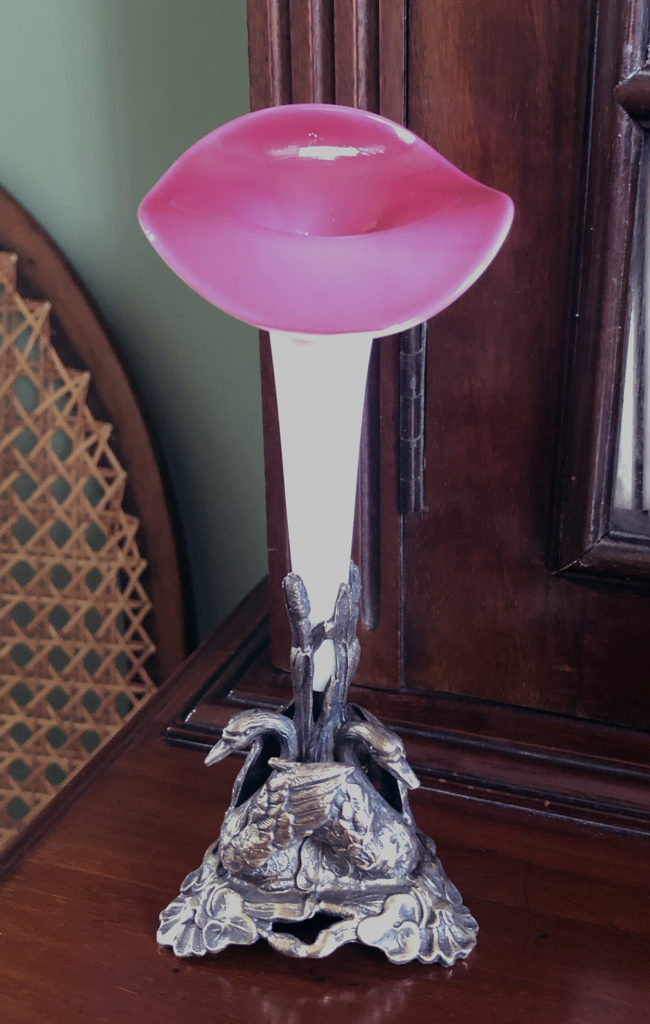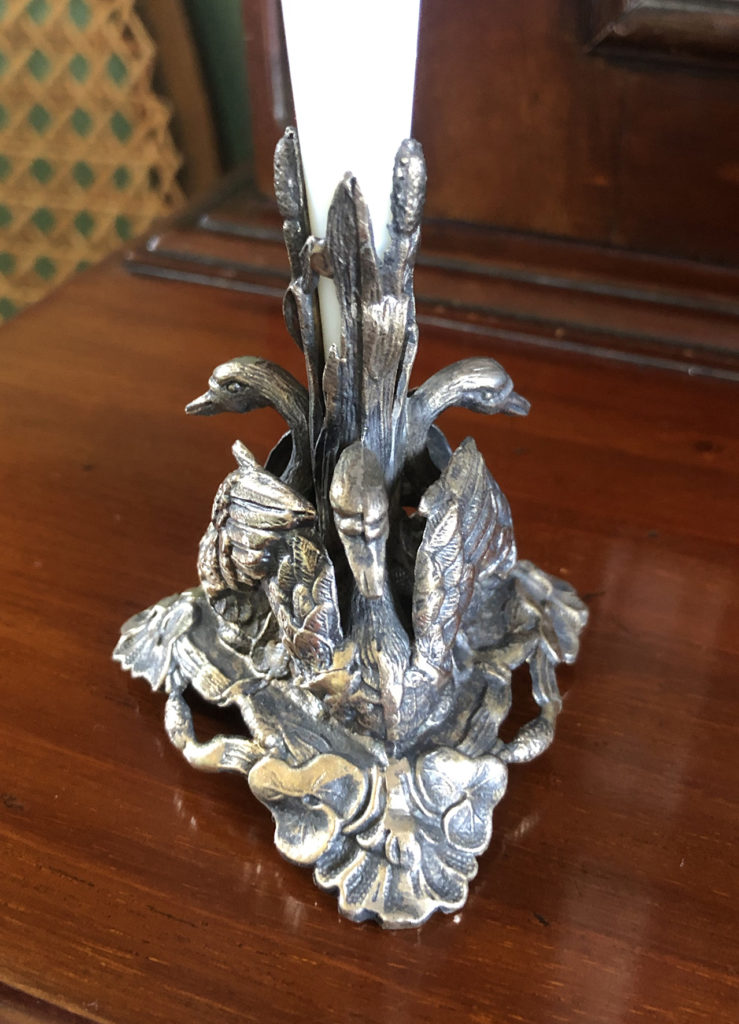I can’t resist a bargain, so when I saw this small epergne on a market stand in Hampstead for £10, I reached for my wallet. The detail of the pewter base is wonderful, being made up of three swans with outstretched wings on a base of lily leaves and branches evoking a pond. A group of bullrushes above them forms the holder for the glass. The glass is opaque white, lined inside with a shocking pink. The form is known as ‘Jack-in-the pulpit’, which is based on the flower of Arisaema triphyllum with its extravagant trumpet like form.

Every aspect of this piece shouts Victorian fashion and, dare I say, erm, kitsch. The style of is typical of the Art Nouveau period, which saw its roots in nature (pun intended), the pink and white glass is also typical of the late Victorian period, and there can be few things as Victorian as an epergne. For those of you who don’t know, epergnes came in many sizes, with more common examples being much larger and usually having more than one ‘trumpet’, typically made from glass, mounted on a metal base. They were used for displaying flowers, fruits, or desserts, and sometimes candles. These large examples were used as centrepieces for grand Victorian dinners.
I wondered who may have made such a small 6in (15.5cm) high example, as it is unmarked, but clearly of good quality. Googling around, I found another example moulded with a registered design number – 12132. Checking my list of British patent numbers, I was able to see that the design was registered some time in 1884. The point of registering a design in such a manner was to protect it from being copied, or ‘ripped off’, by another company. As my example isn’t marked with the registration number, I wonder if it was made after the registration protection period ran out, 14 years after it was registered.

I decided to take it a step further, to satisfy my curiosity. Amongst its vast holdings, The National Archives holds copies of all the designs registered in Britain since such records began in 1839. A simple online search enabled me to find the name of the registrant. If you really want to pursue it, you can then search for the design register that contains the registration and apply online to see if the entry can be photographed. If so, for a small fee payable online, the page will be photographed and emailed to you in a few weeks’ time. I went the whole hog, and you can see what I received below. I’ve overlaid the page from the register with images of the epergne in Photoshop – they didn’t have colour photography like that back in 1884!
It transpired that the design registration for my small epergne was only for the metal base. This was presumably so that different types and colours of glass holder could be inserted. That makes sense as the other examples I found online had different coloured glass ‘trumpets’ – all undoubtedly sourced from factories in Stourbridge, the heart of the British glass industry. The design “For the pattern of a Flower stand” was registered on 30th August 1884 by Phillip Ashberry & Sons Ltd, who are listed as ‘electro platers’ in Bowling Green Street, Sheffield.

Philip Ashberry was founded in 1829 and initially made homewares out of Britannia metal. They added ‘& Sons’ in 1856, and gained the ‘Ltd’ suffix in 1900. It remained a family-owned company until 1935, when it was acquired by Lewis Rose & Co. Ltd. In 1969, they were acquired by Spear & Jackson, and in 1976, they were sold to Guy Degrenne. It appears that throughout the changes, the Ashberry name was retained and used where possible, indicating that it held some prestige with the public back in the day.
Curiosity satiated! I often like to wonder who bought the things that pass through my hands when they were new. After all, antiques were brand new objects at some point. I guess it’s the sort of thing a well-to-do Victorian lady may have had on her dressing table, or perhaps in front of a place setting on a smart dinner table, displaying a pretty posy. I wonder what conversations and shared confidences it heard! Now it sits on my desk, waiting for Spring to come and supply some tiny flowers to display in it.

